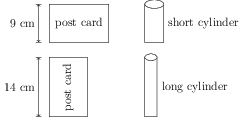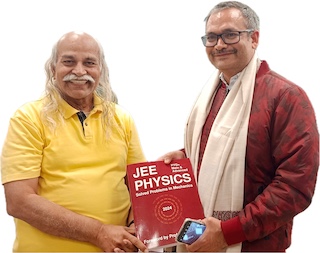Measurement
The students are introduced to the concepts of length, area, volume, mass and density in early classes. The teaching method is mostly based on formula and its application. This does not create a physical sense of these quantities. In this activity, the students not only measure and calculate these quantities but also develop a physical sense about them.
Procedure
Measure the length and width of the post card and calculate its area. Fold a postcard and bring its two short edges together. Use tape to join the short edges to make a short cylinder. Fold another postcard and bring its long edges together. Join the long edges to make a long cylinder. Calculate radius of each cylinder (note that perimeter of a circle of radius \(r\) is \(p=2\pi r\), where \(\pi=22/7=3.14\)). Calculate the volume of each cylinder by using the formula \(V=\pi r^2 h\), where \(h\) is height of the cylinder. Now fill sand (or wheat/rice etc.) in both cylinders. Which cylinder contains more sand? It should be made clear what does `more' means?

Measure the mass of the sand from each cylinder using a balance. For the sand from each cylinder, divide the mass by its volume. Is the ratio same (or nearly same)? This ratio is called density of the sand i.e., \(\rho=m/V\).
Discussion
The students should be introduced to the concept of least count (minimum error in measurement) of the measuring instrument. What are the least count of the scale and the weighing balance. Also, they should be introduced to the zero error of the weighing balance and the procedure to correct it. The students in higher classes should be introduced to the propagation of measurement error. If \(\Delta s\) is the least count of the scale then error in measurement of length \(l\) is \(\Delta l=\Delta s\) and error in measurement of width \(w\) is \(\Delta w=\Delta s\). The error in calculation of the area (\(A=lw\)) is \(\frac{\Delta A}{A}=(\frac{\Delta l}{l}+\frac{\Delta w}{w})\). The error in calculation of the radius (\(r=l/2\pi\)) is \(\Delta r=\Delta l=\Delta s\). The error in measurement of volume (\(V=\pi r^2 h\)) is \(\frac{\Delta V}{V}=2\frac{\Delta s}{r}+\frac{\Delta s}{h}\). If \(\Delta m\) is the least count of the balance then error in density is \(\frac{\Delta \rho}{\rho}=\frac{\Delta m}{m}+\frac{\Delta V}{V}\).
Measuring Length
Measuring Mass
Measuring Volume
Measuring Density
Measuring Pressure
Related
Subscribe to our channel
